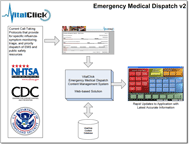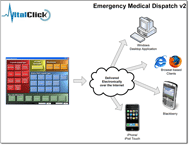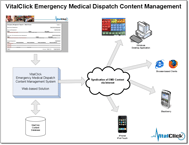

 |
||
EMD Desktop V-1 : The National Highway Traffic Safety Administration (NHTSA) requires that dispatchers use these guide cards, referred to as Emergency Medical Dispatch Protocol Reference System (EMDPRS), when answering medical emergency calls. |
||
The EMDPRS is a set of systematized pre-arrival instructions that include protocols that predetermine vehicle response mode and configuration. The protocols must reflect a given agency's varied ability to respond, ranging from single unit volunteer squads to multiple level response. The use of a standardized and medically approved EMDPRS makes giving medical information consistent and accurate - as all callers receive the same information, in the same manner, every time. |
||
While EMDPRSs tend to differ in coding, protocol construct and design, they all include the thirty-two most commonly defined chief complaints. The VitalClick EMD desktop application replicates New Jersey’s existing manual EMDPRS - down to the colors and content. It was developed relying on hard code; using Visual Basic .NET 2005. |
||
VitalClick V-2 CMS : Further, the VitalClick-CMS will allow a given agency the ability to update and/or modify their localized protocols in a controlled, consistent and timely manner as required by the national standards. The invention specifically will allow for timely and consistent updates during a period of national crisis such as a catastrophic epidemic – which is required by the U.S. Department of Transportation’s “National Strategy for Pandemic Influenza”. Through a single web-based user-interface, the software allows VitalClick the ability to manage content for their Desktop application, web-based clients, and mobile devices. Client or jurisdiction required updates, can be made without modifying, building, and re-testing application code. |
||
As a data driven approach, the VitalClick-CMS software enables it to provide data for other devices and applications as driven by market requirements. As the user base grows, the VitalClick-CMS invention will allow it to maintain data for the applications without requiring exponential time and cost. The VitalClick-CMS software gives licensed users a distinct competitive advantage in terms of response and lowered cost in delivery of applications and subsequent maintenance. VitalClick content-based (VitalClick-CMS) software enables several types of deployment for Internet and mobile devices. With this strategy, it is able to support the widest possible range of devices for delivery of life-saving protocols and information. |
||
EMD Web : |
||
EMD Mobile : |
||
Mobile and Portable devices : RIM, Microsoft, and Apple are offering solutions that enable enterprise environments to deploy these applications using existing infrastructure. An IT department of an institution will easily install these solutions. |
||


